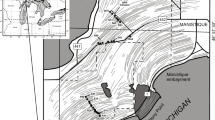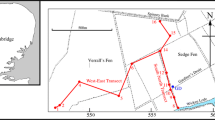Abstract
Door County, Wisconsin, is a region of karst topography underlain by Silurian dolomite bedrock. Numerous sinkholes intercept much of the surface runoff and act as sites for direct groundwater recharge. The clay-rich and impermeable Upper Ordovician Maquoketa formation separates the dolomite aquifer from the deeper aquifers and appears to be a factor in groundwater circulation and karst formation Thin glacial drift and Quaternary materials overlie the dolomite and are hydrologically connected with it
The interactions of surface and groundwater, and the role of solution features in water interchange were studied in a small drainage basin. This basin contains several large sinkholes and a nearby spring complex Mapping identified many additional sinks and swallets in surface drainage routes Water flowing into two sinks was traced and found to have a residence time of several hours. Water flowing into sinkholes and from the spring was sampled to identify the quality and seasonal trends in composition of the shallow groundwater Water quality parameters monitored include magnesium, sodium, potassium, chloride, phosphorous, nitrate and ammonia, nitrogen, alkalinity, pH, turbidity, and specific conductance. Nitrate levels were found to increase 5 to 6 times during periods when there was zero input through sinkhole recharge sites. Nitrate levels approached the 10 mg/l NO3 −-N limit set by the U.S. Public Health Service for drinking water
In this basin sandy soils are most susceptible to sink development, whereas clay-rich soils have a lesser number of sinks. It appears, however, that a network of bedrock solution features exists under all soils The loss of soil into sinkholes has impacted groundwater quality and reduced agricultural productivity through a reduction in tillable acreage and water retention capacity.
Similar content being viewed by others
References Cited
American Public Health Association, Standard methods for the examination of water and waste water, 15th edition, 1980.
Environmental Protection Agency, 1976, Methods for chemical analysis of water and wastes: EPA-60014-79-020.
Sherrill, M. G., 1978, Geology and ground water in Door County, Wisconsin with emphasis on contamination potential in the Silurian dolomite: United States Geological Survey, Water Supply paper 2047, 38 p.
Stieglitz, R. D., 1984, Karst landforms of eastern Wisconsin: Geol. Soc. Amer., North-Central section, Abstracts with Programs, v. 16, no. 3, p. 200.
Stieglitz, R. D., J. H. Wiersma, L. D. Cecil, and G. M. Metzler, 1983, Bedrock control of groundwater and surface water interactions in southern Door County, Wisconsin: Geol. Soc. Amer. North-Central section, Abstracts with Programs, v. 15, no. 4, p. 213.
Author information
Authors and Affiliations
Rights and permissions
About this article
Cite this article
Wiersma, J.H., Stieglitz, R.D., Cecil, D.L. et al. Characterization of the shallow groundwater system in an area with thin soils and sinkholes. Environ. Geol. Water Sci 8, 99–104 (1986). https://doi.org/10.1007/BF02525563
Issue Date:
DOI: https://doi.org/10.1007/BF02525563




